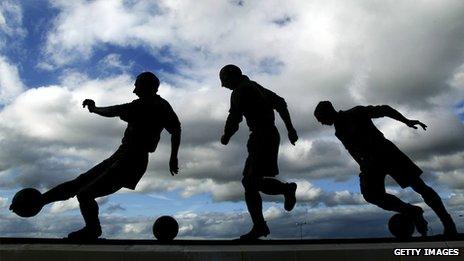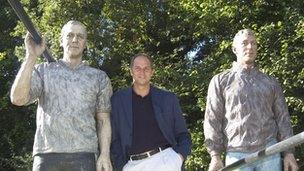Pitch to Plinth: Why do sporting statues exist?
- Published

Three nine-foot statues were made of former Stoke City player Sir Stanley Matthews after his death in 2000.
Footballing legends including George Best, Stanley Matthews, Billy Bremner and more recently Thierry Henry are just a handful of men who have all been cast in bronze.
More than 100 statues have been made dedicated to sportsmen across the United Kingdom.
Sheffield University has spent the past year researching the monuments, creating the first everdatabase of sporting statues, external.
From Pitch to Plinth: The Sporting Statues Project asks why they exist.
Dr Chris Stride, a statistician at the university, said the erection of statues to sporting greats was a very recent phenomenon.
"There were just a handful, maybe four or five that had been erected before 1980 and then maybe another 10 before 1995.
"Suddenly there has been about 100 of these statues built of sports people in the last 15 years."
'Basking in reflective glory'
It is believed that the first sporting statue was made to honour Reading motorcycle ace Bernard Laurence Hieatt, who was killed in a crash at Brooklands in 1930.
The recent popularity of sculptures dedicated to sportsmen is thought in part to be due to the rise of celebrity culture.
"Sports people are seen as celebrities, they never used to be. The sort of people who would have been statue subjects, such as politicians and people of the church and royalty are less popular now," said Dr Stride.

Sir Steve Redgrave is one of only five male Olympians believed to currently have a statue
The university found that the recent surge in footballers being depicted in statues was mainly down to the football clubs appealing to nostalgia and "basking in reflective glory".
"Fans want to hold onto their past, especially if they move to a new stadium," said Dr Stride.
In 2005 Coventry City moved from Highfield Road to the Ricoh Arena and installed a statue of TV presenter Jimmy Hill.
He was honoured not for his skills on screen but as manager for six years who was widely credited with responsibility for Coventry City's promotion to the old Division One in 1967 and his subsequent work to see players better paid.
Strangely it is thought that no sporting women have been replicated in bronze.
The nearest example that could be found was of 15-year-old Camilla Hamilton who died in 2003 in a car accident.
A memorial of the teenager playing hockey was created at her school in Essex, however the statue was stolen several years later in 2010.
'Sport is our religion'
Despite some very successful UK Olympians no females have been celebrated in this way and only five male athletes have been cast in bronze.
Dr Stride said: "Who is going to pay for a statue of an Olympian? It would have to be a group of fans.
"Do fans support an individual in that way? It has to be done by public subscription that someone has to have the idea to do."
Many people use the celebrated casts as a focal point, some laying flowers to mourn the death of a member of the football club or to protest against the latest manager.
But Dr Stride believes there are bigger forces at play in the increasing popularity of statues dedicated to sporting heroes.
Dr Stride said: "There is definitely a link between the development of statues and the role of religion in our society and the change in the way we mourn.
"It used to be that if a great player died there was a minute's silence and so when you have a really great player who dies you need something more.
"Perhaps sport is our religion now, with the decline in organised religion, sport has filled that gap."
There are currently 120 statues in situ dedicated to specific sportsmen in the United Kingdom with a further 20 currently being planned.
- Published13 July 2011